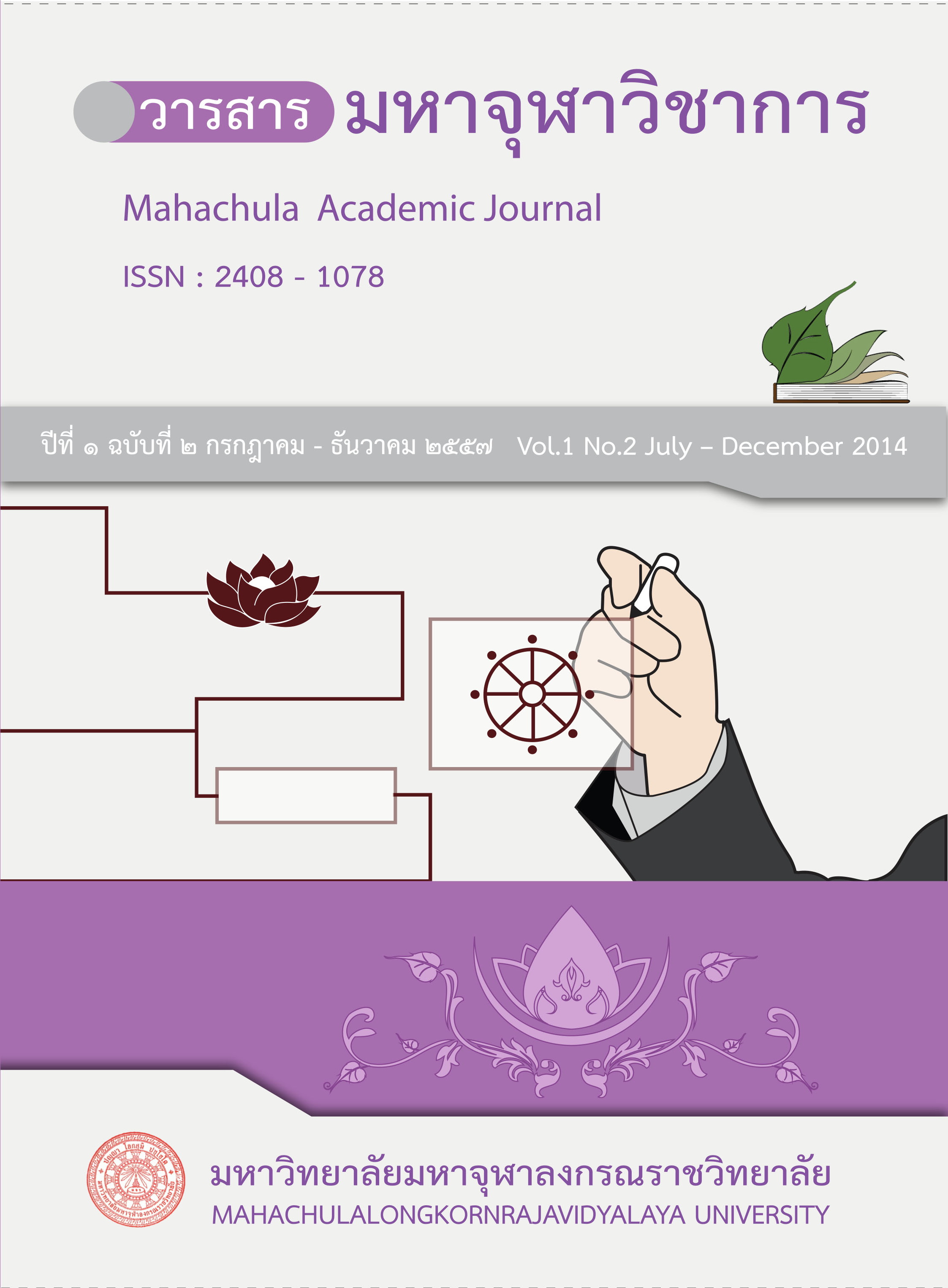Buddhist Educational Research
Main Article Content
Abstract
Buddhist Educational Research is the attempt to present research methodology of the Lord Buddha. The objective of this research is Bothiñaṇa (Enlightenment) by setting up three hypotheses namely: hypothesis 1. “I am the excellent one in the world, I am the big and the precious one in the world, my birth is the final birth, in the next future my birth is not started again.” This hypothesis is set up by the Lord Buddha when he was born from princess Sirimahāmāyā at Lumpinīvana. Hypothesis 2. “To renounce the world as the monk will make him getting peacefulness.” This hypothesis is set up by the Lord Buddha when he saw an old person, a sick person, a dead person and a monk. Hypothesis 3. “Spiritual diligence with practice according to the Middle Way is the way leading to overcome suffering.” This hypothesis is set up after performing Dukkarakiriyā (self-modification). He realized that Dukkarakiriyā is not the way of Bothiñaṇa, is not the way leading to overcome suffering. Research methodology of the Lord Buddha is an experimental research with observational instrument and measurement after experiment by himself. The results of research were as follows:
- All animals are difference in capacities which depend on Kamma (volitional action) and these capacities are the beginning point of Buddhist education. All animals can start to develop themselves until Bothiñaṇa.
- All animals can start to develop the capacities with three wholistic developments namely : relations with environment, spirit and true knowledge.
- All animals can start to develop the capacities with three Buddhist educations namely: Sila (Adhisīlasikkhā)Training in higher morality, Smathi (Adhicitta-Sikkhā):Training in higher mentality and Pañña(Adhipañña-Sikkhā):Training in higher wisdom.
4. All animals can start to develop the capacities to occupy Bothiñaṇa with integration between Sīla and relations with environment, Samādhi and spirit and Pañña and true knowledge
Article Details
References
กรมการศาสนา. แนะนำสังเวชนียสถาน ๔ ตำบล เพื่อเฉลิมฉลองพุทธชยันตี ๒๖๐๐ ปี แห่งการตรัสรู้ของพระพุทธเจ้า. กรุงเทพมหานคร: กระทรวงวัฒนธรรม:กรมการศาสนา, ๒๕๕๕.
คู่มือหลักสูตรพุทธศาสตรดุษฎีบัณฑิต. สาขาวิชาพุทธบริหารการศึกษา. กรุงเทพมหานคร: โรงพิมพ์มหาจุฬาลงกรณราชวิทยาลัย, ๒๕๕๕.
ชัยวัฒน์ อัตพัฒน์ และ วิธาน สุชีวคุปต์. หลักการดำรงชีวิตในสังคม. กรุงเทพมหานคร: รามคำแหง, ๒๕๓๙.
เดโช สวนานนท์. ปทานุกรมจิตวิทยา. กรุงเทพมหานคร: โอเดียนสโตร์, ๒๕๒๐.
บัณฑิตวิทยาลัย. ผลการวิจัยและวิทยานิพนธ์ดีเด่นของมจร. กรุงเทพมหานคร: หอไตรการพิมพ์, ๒๕๕๓.
พระธรรมปิฎก(ป.อ.ปยุตฺโต). พุทธธรรม(ฉบับเดิม). กรุงเทพมหานคร: โครงการตำราฯ วรรณไวทยากร, ๒๕๔๖.
พระพรหมคุณาภรณ์(ป.อ.ปยุตฺโต). กาลานุกรม. นครปฐม: วัดญาณเวศกวัน, ๒๕๕๒.
พระศรีคัมภีรญาณ(สมจินต์ สมฺมาปญฺโญ). ลุมพินีวันสมัยพุทธกาล : แนะนำสังเวชนียสถาน ๔ ตำบล. กรุงเทพมหานคร: กระทรวงวัฒนธรรม : กรมการศาสนา, ๒๕๕๕.
พระศรีคัมภีรญาณ(สมจินต์ สมฺมาปญฺโญ). เส้นทางเสด็จก่อนถึงเมืองกุสินารา : แนะนำสังเวชนียสถาน ๔ ตำบล. กระทรวงวัฒนธรรม: กรมการศาสนา, ๒๕๕๕.
พระอุดรคณาธิการ(ชวินทร์สระคำ). ประวัติศาสตร์พุทธศาสนาในอินเดีย. กรุงเทพมหานคร: มหาวิทยาลัยมหาจุฬาลงกรณราชวิทยาลัย,๒๕๓๔.
มหาวิทยาลัยสุโขทัยธรรมาธราช. การเรียนรู้การทำวิจัยด้วยตนเอง. มหาวิทยาลัยสุโขทัยธรรมาธิราช: สถาบันวิจัยและพัฒนา, ม.ป.ป.
มหาจุฬาลงกรณราชวิทยาลัย. พระไตรปิฎกภาษาบาลี ฉบับมหาจุฬาลงกรณราชวิทยาลัย. กรุงเทพมหานคร: โรงพิมพ์มหาจุฬาลงกรณราชวิทยาลัย, ๒๕๓๕.
มหาจุฬาลงกรณราชวิทยาลัย. พระไตรปิฎกภาษาไทยฉบับมหาจุฬาลงกรณราชวิทยาลัย. กรุงเทพมหานคร: โรงพิมพ์มหาจุฬาลงกรณราชวิทยาลัย, ๒๕๓๙.
สถาบันวิจัยพุทธศาสตร์. กรอบยุทธศาสตร์ด้านการวิจัย. พระนครศรีอยุธยา: มหาวิทยาลัยมหาจุฬาลงกรณราชวิทยาลัย, ๒๕๕๖.
สำนักงานเลขาธิการสภาการศึกษา. การวิจัยทางการบริหารการศึกษา. กรุงเทพมหานคร: เจริญผล, ๒๕๔๗.
สมเด็จพระพุฒาจารย์ (เกี่ยว อุปเสโน). เย็นหิมะในรอยพระธรรมและบาบิยัน. กรุงเทพมหานคร: มหาวิทยาลัยมหาจุฬาลงกรณราชวิทยาลัย, ๒๕๕๕.
Buddhist Research Institute. MCU, Thailand, 2012.
The International Association of Buddhist Universities. MCU, Thailand, 2012.
Phra Dharmakosajarn. International Buddhist Studies. MCU, Thailand, 2012.


